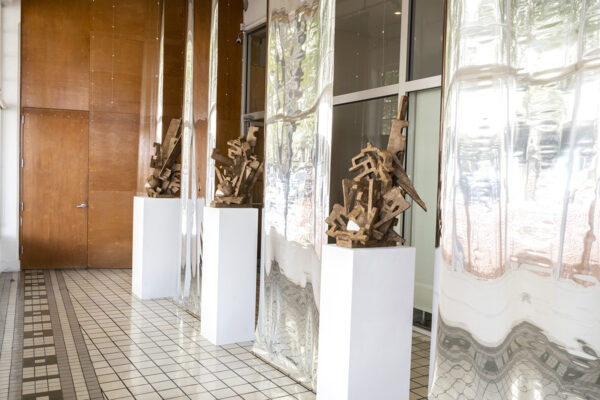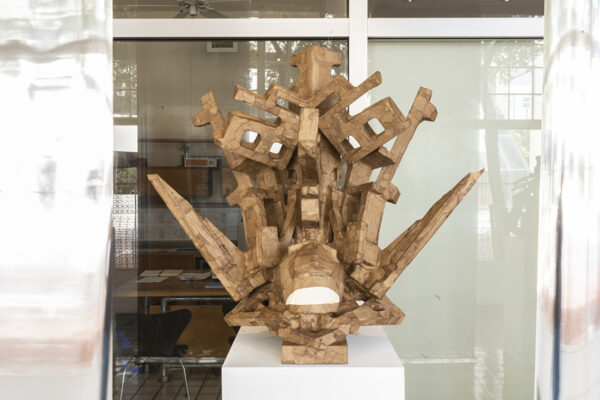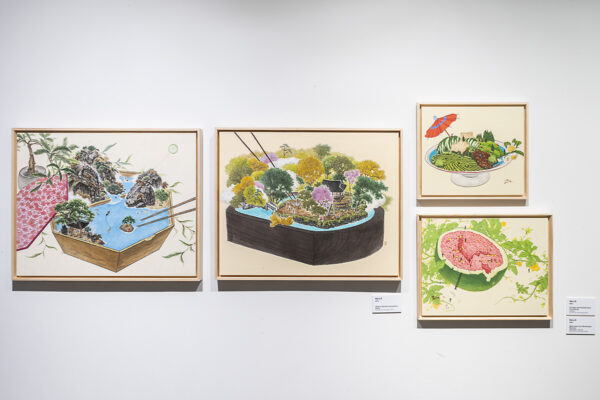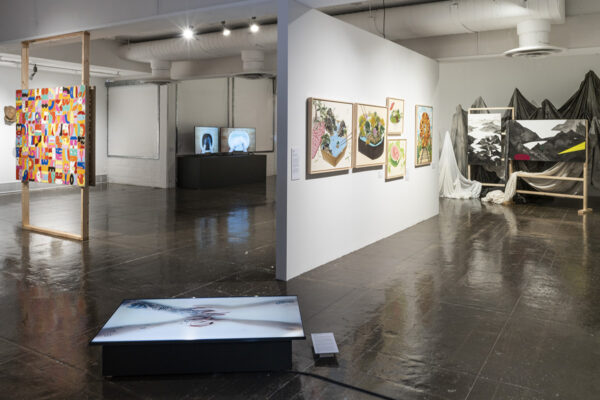
Installation view at Artpace, Luis Valderas, “The Sacred Portal of Amaxactli (place where the waters split),” 2022. Photo by Beth Devillier.
Luis Valderas’s The Sacred Portals of Amaxactli (place where the waters split) — 2022 greets visitors at Artpace’s street-facing Main Gallery as they enter the building’s first floor. Walking into Valderas’s exhibition, one enters a portal. Heads of Aztec gods Tezcatlipoca, Xipe Totec, and Huitzilopochtli are arranged in a row on pedestals, each separated by reflective plastic banners that emulate waterfalls. Noticeably missing, however, is Quetzalcoatl, the fourth mythical god also born of proto-gods Ometecuhtli and Omecihuatl, who along with his siblings is responsible for the creation of the universe.
Valderas has transformed Artpace’s Main Gallery into the Aztec equivalent of Superman’s Fortress of Solitude — drapes of shiny petroleum sheets flutter in the breeze from the air duct; stringed refractive droplets of clear plastic gems hang in tens from the ceiling; delicate disco lights draw red, green, and blue patterns, and dots swim like insects about the entire space. And in that quiet, contemplative room, in between the Aztec gods and the surreal storefront window-facing construction equipment outside, it feels like there is a superhero in the air. In short, Quetzalcoatl — the god of wind, vegetation, water and life; the feathered serpent who tricked and fought Death in the underworld to give birth to humanity by mixing his blood with corn — is everywhere, and in everyone in the room.

Luis Valderas, “Xipe Totec Nauhcampa Bust,” 2022, Styrofoam, packing paper, glue, wood, ceramic. Photo by Beth Devillier.
Each of the god-heads are made of Styrofoam covered in brown bag paper mâché, constructed into machine-like armor resembling Transformers — emulating the Aztec illustrations of gods in the codices, each of whom fan out onto the pages like fantastic, exploding mechanical parts. They dare souls to enter into an otherworldly realm, to be transformed, and to be reborn.
Upstairs, ten artists from Gwangju are showing as a part of an exhibition commemorating the 40th year of the sister city partnership between San Antonio and Gwangju. Our Step, Our Hope: Sister Cities: Gwangju to San Antonio brings the impetus for transformation, in the form of getting in touch with new cultural influences, in language and expression.
The first work facing the entrance is a video on an LED display on the floor. Two pairs of hands are playing cat’s cradle, or silddeugi in Korean — a game of hands threading a bound string into various geometric shapes. Representing a coming together between two cultures, Eunsol Cho’s The Type of Relationship – Touch (2019) starts the process of dialog between San Antonio and Gwangju, the historic southwestern city of South Korea that represents democracy through popular protest in Asia. Next to the video display, three large paintings by Jaeghil Woo describe the profundity of this exchange, their irregular trigonometric patterns resembling lightning or cracking glaciers. In works including Light 2010-13A (2010), a connection glimmers between the light refractions cast by these shapes and those that welcomed visitors at Valderas’s show.
Just as Valderas spoke of industrialization through materiality of packing and shipping, on the opposite side of that wall is a 3D video projection of dancing Coke cans. Yonghyun Lim’s Tik Tok (2020) is a souped-up Warholian choreograph, and it is ambivalent about the ubiquity of Coca Cola as a symbol for globalization, a process that began in the Americas in the 16th century with the conquistador Hernán Cortés, who was mistaken for Quetzalcoatl by the indigenous people and welcomed by the Aztec Emperor Montezuma II. It was through the ensuing violence and colonization that the term “mestizo” was adopted into the continent. As uncertain as Lim’s work speaks to the absurdity of pop vernacular, Valderas’s work and its remaking of industrial materials grounds this remixing process as defining the spirit of the Americas as it stands today.
Further ahead are a series of faceless plaster and resin busts, by Junggi Lee, installed on the wall. In The Present People (2019), each head looks to be covered entirely by a cloth casing, in various states of acceptance to their arrested fate. Some are craning their necks, straining to try to free themselves. Others are resolute and silent. These anonymous masks refer to the Gwangju Uprising of 1980 — student protests against an authoritarian government that led to many deaths in the ensuing crackdown, which is considered by many the starting point of democracy in South Korea. The anonymous faces could be anybody, and in the context of South Texas and the border, one could cast new meaning on these odes to lives and voices lost.
Death is the theme in the two-channel video work Two to Tango (2020), also by Eunsol Cho. Each display shows a video of a hand being dipped in latex paint, its left side black and right side white. The paint, after it dries, is eventually peeled off. Voiceovers and on-screen captions narrate a story about memories, depression, and suicide. It’s a work that highlights the social issue of mental health in South Korea, which has the highest rate of suicide per capita among Organisation for Economic Co-operation and Development (OECD) countries, with causes attributed to a heavy drinking culture and inadequate social support systems for older, socio-economically disadvantaged folks. Nearby, Family Story (2015) by Youngsung Hwang deals with recovery and mourning. In paintings that narrate the personal stories of the artist’s kinship with family members that he lost, the square-framed pictographs used by the artist resemble colorful reinterpretations of Mayan glyphs.
Memories as sites of recovery and renewal continue to be explored in Leenam Lee’s dual-channel work The Warmth of a South-Facing (2022). The artist reanimates historical paintings by Uijae Baek-ryun Huh and Jiho Oh by inserting an avatar of his younger self and his dog into the pictures. The pair wander through the time lapses between the two displays, contemplating the healing properties of a mountain landscape with running water by Huh and the moving shadows of a tree trunk against the backdrop of a traditional Korean house by Oh.

Installation view of work by Haru K in “Our Step Our Hope,” on view at Artpace. 2022. Photo by Beth Devillier.
At the other end of the gallery, one can find a mountain range in an installation work by Seol Park, It’s About an Incomplete Landscape (2020). Using a traditional Korean ink-based painting technique called sumuk, the artist creates collages using ripped pieces of paper resembling mountains through gradient washes of black, and bright geometric shapes that act as contemporary interventions. The two collages are nestled between cones of fabric dyed in washes of black ink that have been draped from the ceiling, a three-dimensional backdrop to the flatness of the Korean paper. It’s a work that breaks open the collapsed spaces of traditional Korean ink paintings into our dimension. Another type of natural scenery local to the southwest coast of the Korean peninsula are mudflats, which in 2021 were designated a UNESCO world heritage site their unique ecological makeup. This landscape is the subject of a backlit traditional rice paper painting, Trace (2018) by Seonhooi Cheng, which is imbued with a nostalgic and romantic look by the changing blue light of the night sky.
Beyond memories and recollections, in Namjin Lim’s work, tradition meets the everyday. In To the Wind (2010), a woman sits and dons a moisturizing beauty mask, holding a mirror up to her face while seated underneath a willow tree whose rotating trunk rises from the floor of a folded paper boat. In this surreal scene, the leaves of the willow tree are replaced by golden lights that either resemble Christmas decorations or the patterns that make up Yayoi Kusama’s pumpkins. These blowing lights float throughout the composition, scattering like lightning bugs. It’s a breezy work about the sacred nature of private spaces, and the relaxation of a beauty routine.
Korean paper is also the surface on which Haru.K explores a landscape made of food. In Shoot! (2022) (the title is an onomatopoeic pun for ‘bread’ in Korean), a mung bean pastry, equivalent to a Korean pan dulce, takes center stage and is riddled with bullet holes and hung like a celestial entity in the middle of the composition. Train tracks extend out into the pastry, surrounded on either side by brush and cacti, as tiny, fairy-like human figures interact within and contemplate this comical East-West remix. This cross-cultural pop is a greeting across the seas and across the portal by Luis Valderas — from the birthplace of South Korean democracy, to the birthplace of American democracy in the West, with its violence, flaws, reclamations, and all.
The Sacred Portals of Amaxactli (place where the waters split) and Our Step, Our Hope are on view at Artpace, San Antonio through January 1, 2023.




